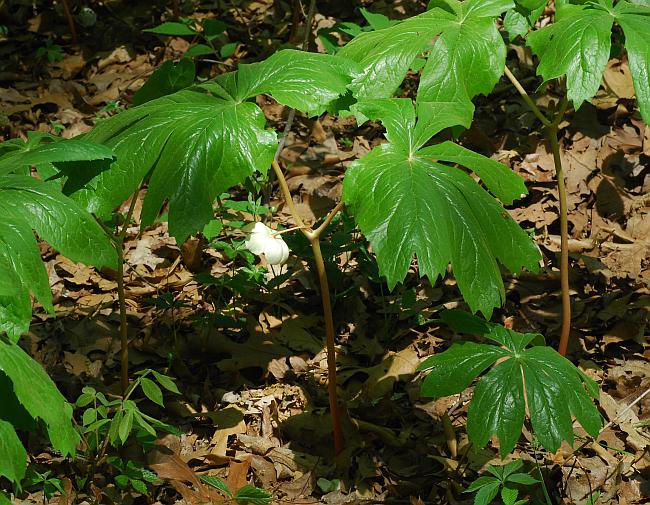Podophyllum peltatum L.
May Apple

Native
CC = 4
CW = 3
MOC = 73
© SRTurner
Podophyllum peltatum L.May Apple | |
 |
Native CC = 4 CW = 3 MOC = 73 |
© SRTurner |
|
Family - Berberidaceae Habit - Perennial forb, 20-50 cm tall, with long creeping branched rhizomes 4-7 mm thick, strongly colonial. Stems - Vegetative portions with one leaf attached directly near the tip of the rhizome, fertile portions with 2 leaves attached at the tip of an aerial stem, this erect, glabrous.
Leaves - Simple, the blade palmately veined, often perfoliate, 18-35 cm in diameter, deeply 5-9-lobed, the lobes oblanceolate, sometimes further 2-lobed, the margins toothed, the upper surface green, the lower surface glaucous. Fertile stems with two leaves per plant, opposite and terminating stem, petiolate, peltate. Petioles to 8 cm long, glabrous. Leaf surfaces glabrous or hairy.
Inflorescence - Flowers solitary, appearing from the angle between the leaves, without bracts, usually nodding. Pedicel to 4 cm long, glabrous.
Flowers - Sepals 6, orbicular to broadly ovate, falling very early as the flowers open, green, glabrous. Petals 6-9, 15-33 mm long, white, glabrous, without nectaries. Stamens 12-18, the anthers attached at the base, opening by longitudinal slits. Ovary glabrous, superior, 7-8 mm in diameter, 1.1 cm long, cylindric, slightly contracted at both ends, unilocular. Placentation parietal. Stigma sessile, globose.
Fruits - Ellipsoid berries, 25-45 mm long, 20-36 mm in diameter, yellow when ripe. Seeds enclosed in a yellow (rarely purple) aril.
Flowering - March - June. Habitat - Mesic and bottomland forests, ledges of bluffs, pastures, roadsides, and railroads. Origin - Native to the U.S. Lookalikes - None. Other info. - This widely recognized plant is a common sight in the springtime woodlands of Missouri. It is found throughout the state, and also across the eastern half of the continental U.S. and parts of Canada. The umbrella-like plants, usually forming extensive colonies which may reach several meters in radius, are unmistakable in appearance. It is common knowledge that flowers are only formed on two-leaved plants which have a forked stem. Flowers are easily found at the right time of year, but fruits are somewhat less common. When ripe, the fruit are edible and sweet, and were an important food source for native Americans. The plant was also used to treat parasites, syphilis, jaundice, and other ailments. However, unripe fruits and all other parts of the plant are poisonous, and human deaths have resulted from inappropriate consumption. The toxicity is at least partly due to podophyllotoxin and related compounds, which are ligans and not alkaloids. Etoposide, a semisynthetic derivative of a Podophyllum lignan, is used in anticancer chemotherapy. Photographs taken at Leawood City Park, Leawood, Kansas, 4-2-00, and in Brown Summit, NC., 7-14-02 and 4-20-03 (DETenaglia); also at Shaw Nature Reserve, Franklin County, MO, 6-18-2006, Engelmann Woods Natural Area, Franklin County, MO, 4-26-2008, Weldon Spring Conservation Area, St. Charles County, MO, 4-18-2010, Canaan Conservation Area, Gasconade County, MO, 5-6-2014, Glassberg Conservation Area, Jefferson County, MO, 4-5-2018, Danville Conservation Area, Montgomery County, MO, 5-8-2018, in Gasconade County, MO, 4-8-2021, and Niangua Natural Area, Dallas County, MO, 4-22-2023 (SRTurner). |